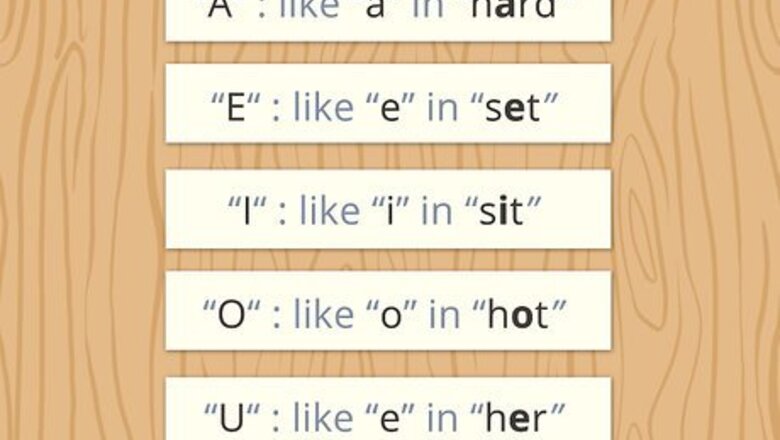
views
Working on Your Pronunciation
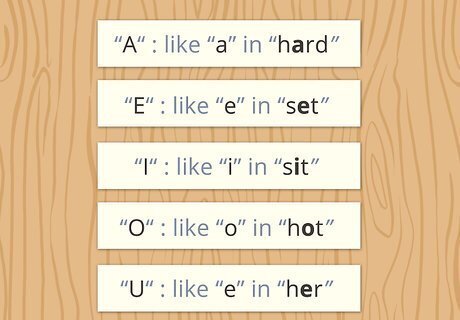
Start by learning the Dutch alphabet. If English is your first language, you’ll find that many letters are pronounced the same in both Dutch and English. However, a few sounds that are unique to Dutch might give you a little trouble. Consonant sounds that are more or less pronounced the same in Dutch and English include: B, C, D, F, H, K, L, M, N, P, S, T, and V. Dutch vowels are pronounced: A (like the “a” in “hard”), E (either like the “e” in “set” or the “a” in “cane”), I (like the “i” in “sit”), O (like the “o” in “hot” or the “oa” in “boat”), and U (say it like the “e” in “her,” but round your lips into an “O” shape instead of keeping them relaxed). In Dutch, “J” is pronounced like the English “Y.” “R” is rolled, like in Spanish, but the sound is pronounced in the throat instead of the front of the mouth. Tricky sounds unique to Dutch include “G” and “W,” and it’ll take some practice to master them.

Practice making the guttural “ghuh” sound. Pronounce “g” and “ch” with a throaty, guttural sound. It’s a bit like the sound you make when you gargle. Note that “ch” is hard, as in the Scottish word “loch,” instead of like the English word “chart.” The consonants in these guttural sounds aren’t voiced; rather, they’re aspirated. Say the English word “zip.” The “z” is voiced, and you feel more of a vibration when you pronounce it. In “sip,” on the other hand, the “s” is unvoiced. Make the “ghuh” and “chuh” sounds with the back of your throat, but try not to voice the consonant sound. Practice saying Dutch words such as “goedemorgen” (ghooh-duh-mawr-ghuh), “goedenacht” (ghooh-duh-nahkht), and “gezellig” (ghuh-zell-eh-ghuh).

Learn the Dutch pronunciation for “W.” The consonant sound “V” is similar in both Dutch and English. “W,” on the other hand, is like a cross between English “W” and “V” sounds. To make the Dutch “W” sound, try to make an English “W” sound with your bottom teeth pressed against your top lip. Practice saying the words for who, what, and where in Dutch: “wie” (wvee), “wat” (wvaht), and “waar” (wvahr).

Work on Dutch vowel combinations. Vowel sounds change when they're used in combination, so memorize how to pronounce each variation. In Dutch, double vowels (such as “aa”) are common, and are generally pronounced longer than single vowels. Additionally, there are several vowel combinations (such as “oe”), which produce sounds that are unique to the Dutch language. Pronounce the double vowels: aa (“ahh”), ee (like the “a” in “may” or, when followed by r, like the “e” in “here”), oo (like the “o” in “no,” or as the “o” in “more” when followed by r), and uu (like “uhh” with the lips rounded and tongue brought to the front of the mouth). Sound out the vowel combinations: ai (rhymes with “I”), au (like "aw" in "awesome"), ei (rhymes with “eye”), ij (same as "ei" in Dutch), eu (somewhat like the vowel sound in “birth,” but with a rounded mouth), ie (rhymes with “we”), oe (rhymes with “who”), ou (like the “ou” in “house”), ui (no English equivalent; it sounds like a cross between “ow” and “oy”).

Look for online lessons and other electronic resources. You can find free instructional videos on YouTube, Duolingo, and other sites and services. Audio and video resources can help you master Dutch pronunciation and build a basic vocabulary. You could also invest in paid educational software, such as Pimsleur, Rosetta Stone, or Babel.
Learning Useful Words and Phrases
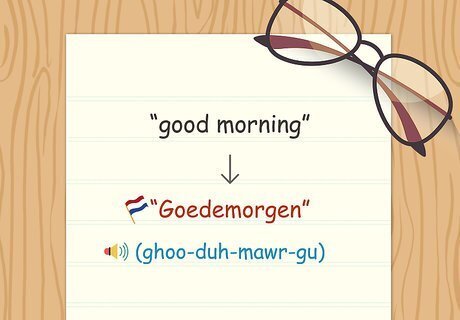
Say “hallo” or “hoi” to greet someone. “Hallo” (hah-loh) is Dutch for “hello.” If you’re greeting a friend, say “hoi” (hoy), which means “hi” or “hey.” Other greetings include: Goedemorgen (ghoo-duh-mawr-guh), which means “good morning.” Remember to make the guttural “gh” sound. Goedemiddag (ghoo-duh-mih-dahgh), or “good afternoon.” Goedenavond (ghoo-duh-nah-fohnt), which is Dutch for “good evening.”
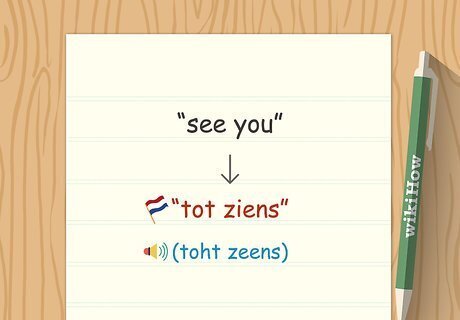
Bid farewell by saying “doei,” “tot ziens,” or “groetjes.” Say “doei” (doo-ee) to tell someone “bye,” or use the more formal “tot ziens” (toht zeens) which means “goodbye” or “see you.” You could also say “tot straks” (toht strahks), which means “see you later today” or “tot zo” (toht zoh), which means “see you soon.” ”Groetjes” (ghroot-yes; the “oo” sounds more like “book” than “choose”) is another informal way of saying “goodbye.” It means “best wishes.” You can also say goedenacht (ghoo-duh-nahkht), which means “goodnight.”

Learn how to say “please” and “thank you” in Dutch. The formal way of saying “please” is “alstublieft” (ahlst-ew-bleeft). The informal version is “alsjeblieft” (ahl-shuh-bleeft). Generally, you can use informal expressions in most social situations. Use the formal version with people in distinguished positions, such as elders or your boss. “Dank u wel (dahnk-ew-vehl) is the formal way to say “thank you.” “Dank je wel” (dahnk-yuh-vehl) is the informal version. You can also use “hartelijk bedankt” (hahr-tuh-lik buh-dahnkt), or “thank you very much.” To say “you’re welcome,” use “graag gedaan” (ghrahgh ghuh-dahn).
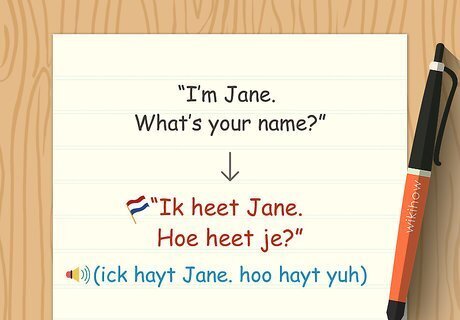
Use “ik heet” to introduce yourself. Say “ik heet” (ick hayt), which means “I’m called,” immediately followed by your name. To ask someone their name, say, “Hoe heet je?” (hoo hayt yuh). The formal way to ask someone’s name is “Hoe heet u?” (hoo hayt ew).

Ask and respond to “How are you?” in Dutch. To informally ask “How are you?” in Dutch, say “Hoe gaat het?” (hoo ghaht ut). The formal version is “Hoe gaat het met u?” (hoo ghaht ut meht ew). Responses include: “Goed” (ghoot), which means “good” or “fine.” “Heel goed” (hayl ghoot), or “very well.” “Het gaat” (uht ghaht), which means “so-so.” “Slecht” (slehkht), which is “bad,” or “niet zo goed” (neet zoh ghood), which means “not so good.”

Memorize practical phrases if you’re visiting a Dutch-speaking country. Many Dutch people speak English, but it’s helpful and respectful to commit a few key phrases to memory before your trip. For instance, instead of just assuming a stranger speaks English, ask “Pardon, spreek je Engels?” (pahr-dohn, sprayk yuh ehng-uhls). Other useful phrases for travelers include: “Ik spreek niet zo goed Nederlands” (ik sprayk neet zoh ghood nay-der-lahnds), or “I don’t speak Dutch very well.” “Mag ik een” (mahg ick uhn), which means “May I have a.” To ask for a coffee, for example, say “Mag ik een koffie, alsjeblieft?” (mahg ick uhn kof-fee, ahl-shuh-bleeft). “Wat kost het?” (wvat kohst ut), which means “How much is it?” “Waar is het toilet?” (wvahr is hut twah-let?), or “Where is the bathroom?”
Building Your Vocabulary
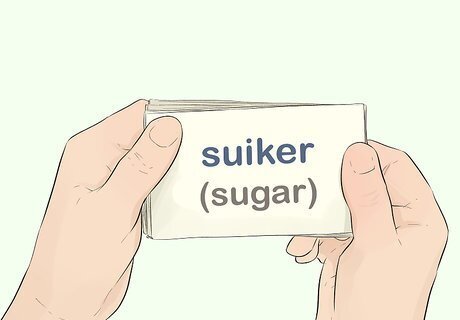
Make flashcards to master daily or weekly vocabulary lists. Work at your own pace, such as by memorizing 1 word a day or studying a daily list of 10 words. Write a Dutch word by hand on one side of a flashcard, and write the definition on the other. Quiz yourself, or have a friend or relative help you study. Writing, reading, and speaking words out loud can make it easier to commit them to memory. Try making themed lists with words related to a single topic. Find vocabulary lists related to colors, food, animals, household objects, professions, and places at http://mylanguages.org/dutch_vocabulary.php.
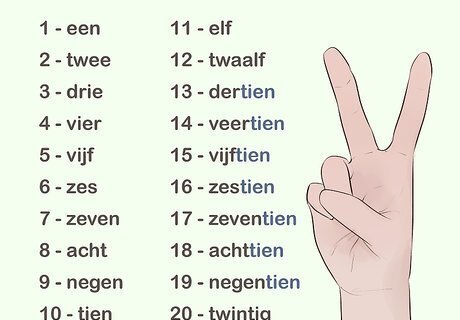
Learn how to count in Dutch. Whether you’re having a basic conversation or ordering at a restaurant, knowing how to say numbers in Dutch is a handy skill. Start by learning how to count up to 20: Een (ain, 1), twee (twvay, 2), drie (dree, 3), vier (veer, 4), vijf (vayf, 5), zes (zehs, 6), zeven (zay-vuhn, 7), acht (ahght, 8), negen (nay-guhn, 9) tien (teen, 10), elf (elf, 11), twaalf (twvahlf, 12), dertien (dehr-teen, 13), veertien (vayr-teen, 14), vijftien (vayf-teen, 15) zestien (zehs-teen, 16), zeventien (zay-vuhn-teen, 17), achttien (ahght-teen, 18), negentien (nay-guhn-teen, 19), twintig (twin-tuhgh, 20). Add the number before the noun it describes just as you would in English. For example, “Mag ik twee vaasjes, alsjeblieft?” (mahg ick twvee vahs-yus, ahl-shuh-bleeft) means “May I have 2 beers, please?”
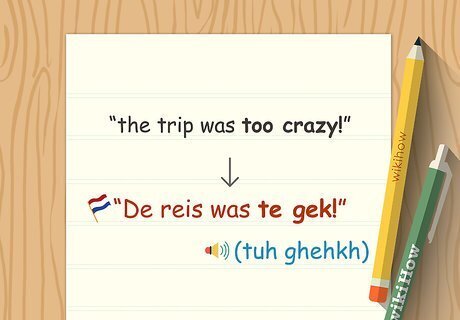
Add slang and idioms to your repertoire. Learn colloquial words and phrases to broaden your conversational skills. For instance, use “Het was leuk” (ut wvahs loke) or “Het was gezellig” (ut wvahs ghuh-zell-eh-ghuh) to say something was fun, cool, or awesome. “Lekker” (it’s pronounced as it’s spelled) can mean “yummy” or “nice.” Use it to describe a tasty meal or to add a positive emphasis to a statement. “Slaap lekker” (slahp lekker), for example, means “sleep well.” “Te gek” (tuh ghehkh), which literally means “too crazy,” is used to describe something as “awesome” or “fun.” If someone asks you how your trip was, for instance, you’d say “Te gek!” “Zeg mar” means “so to speak,” and is sometimes inserted casually into sentences. In English, someone might say, “It’s so, like, cool, but a little weird.” A Dutch person would say, “Het is heel leuk, zeg maar, maar ook een beetje raar” (ut is hayl loke, zehgh mahr, mahr oke uhn bay-tyuh rahr).

Watch and listen to Dutch TV shows, movies, and music. Studying flashcards and vocabulary lists is helpful, but you need to learn how those words are used in conversations. Search YouTube and other music and video streaming services for Dutch content, or check your local library for Dutch films or TV shows on DVD. Even if you don’t understand the words, hearing Dutch dialog can help you get a feel for pronunciation, rhythm, and intonation. Online Dutch dictionaries with audio word pronunciations are also helpful.
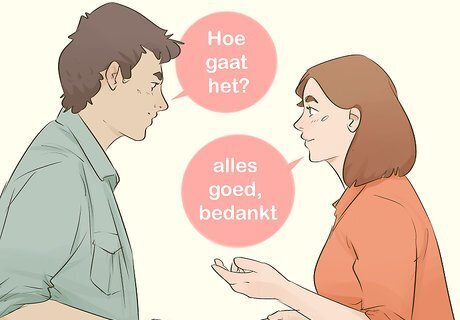
Practice with a native speaker, if possible. If you know someone who speaks Dutch, have simple conversations with them on a regular basis. Speak to each other slowly, work on building your confidence, and ask your friend to correct any mistakes you make. Mistakes are an important part of the learning process, so don't get frustrated or nervous if you make an error. If you mispronounce something or say the wrong word, just jot down the correction in a notebook.

















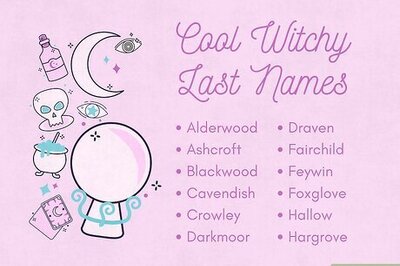
Comments
0 comment